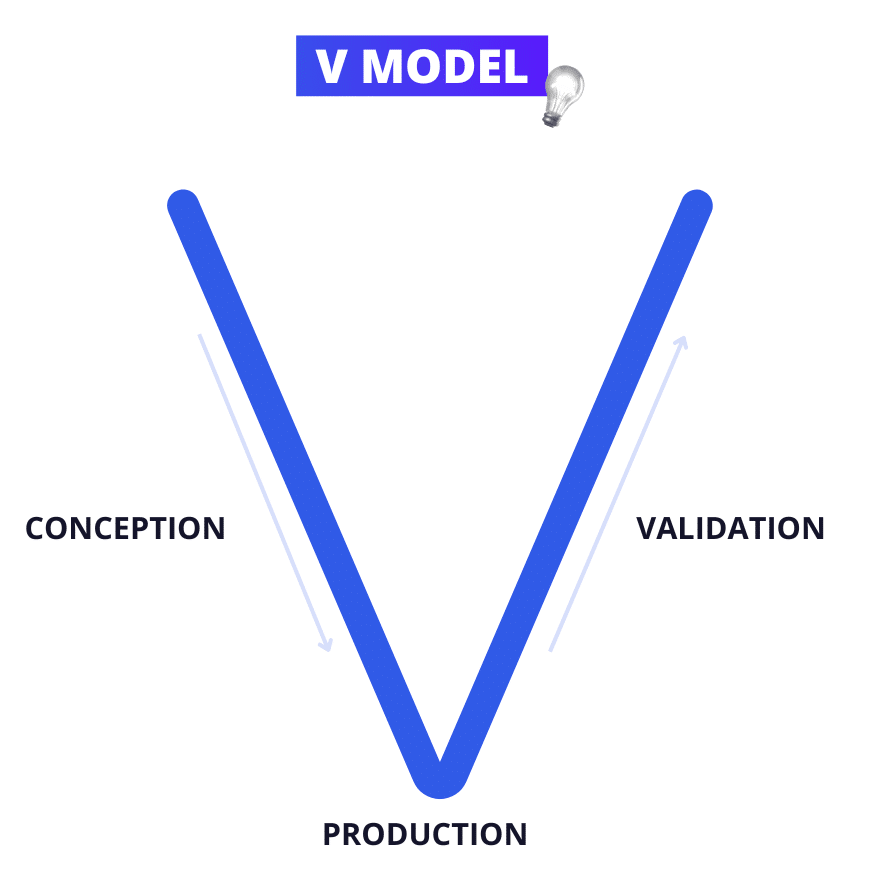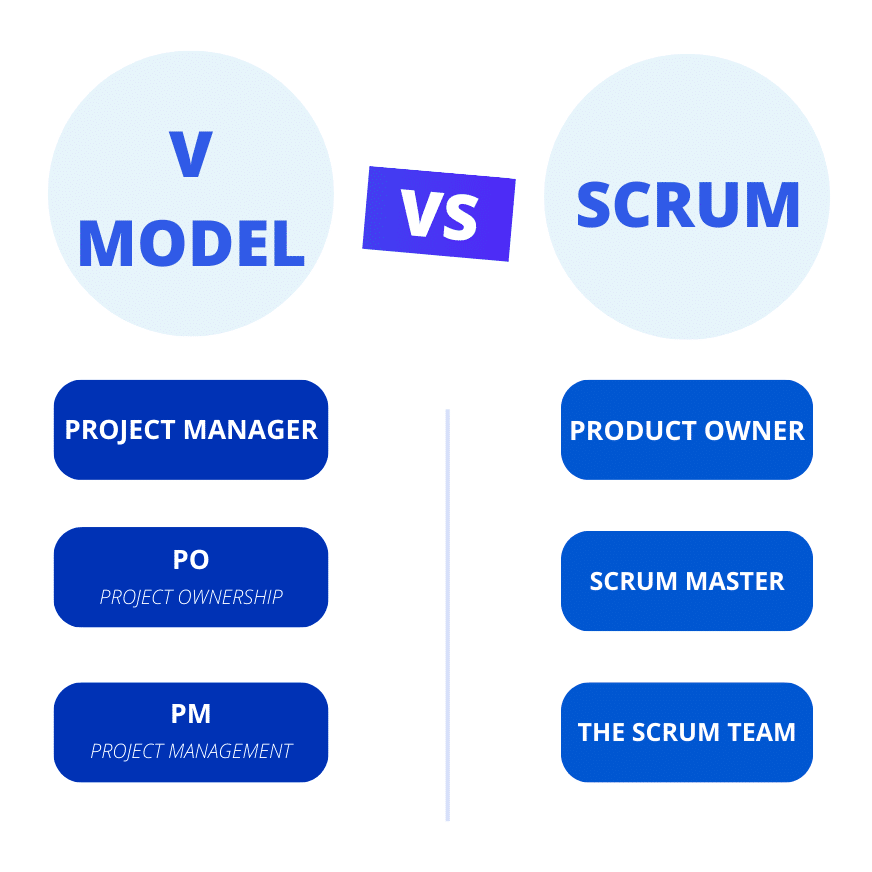Today, we’re not going to talk about the wash cycle, but rather the V model. This project management model is used to represent development processes.
On today’s program :
- Definition.
- Advantages and disadvantages.
- The 9 essential stages of the V model.
- The difference between the V model and the agile method.
Ladies and gentlemen, fasten your seatbelts. 🏎️
V-model definition
The V-model is a methodical approach to project development, often used in software engineering. It takes its name from its graphic representation 📊 in the form of a V-shaped diagram (pictured below), symbolizing the project’s progress from the specification phases through to validation. ✅

This follows a sequence of linear, interdependent phases, with a correspondence between each ascending phase (from the bottom to the V) and an associated descending phase (from the top of the V).
Okay, that was a very theoretical sentence, but what you need to remember is that each phase of the V-model is designed to guarantee the quality, consistency and conformity of the project, throughout its development. 📈
This cycle is made up of 3 distinct phases:
- 🥇 The design phase.
- 🥈 The implementation phase.
- 🥉 The validation phase.
However, this one has several advantages and disadvantages that are important to consider, here they are! ⬇️
V-model advantages
Here’s a list of the advantages of using the V model for your projects:
- Clear structure: it offers a well-defined structure with distinct sentences, making it easier to plan and organize the project.
- Requirements management: the first phase is requirements gathering, so it clearly defines project needs (reducing the risk of constant modifications).
- Thorough documentation: includes detailed documentation at every stage, facilitating subsequent maintenance and understanding of system functionality.
- Risk reduction: emphasizes testing throughout the process, enabling problems to be identified and corrected earlier.
V-model disadvantages
There are, however, disadvantages. Let’s find out what they are:
- Lack of flexibility: less suitable for projects where changes are frequent or when making rapid adjustments.
- Extended development time: takes time to complete a project compared to more iterative and flexible methods.
- Unreliable customer involvement: customer participation and feedback are often solicited mainly during the validation phase, which can limit actions.
The V-model method: the 9 essential steps
As mentioned above, the V-model comprises three main phases. Let’s start with the first, the design phase!
The design phase
The design phase is one of the most crucial stages of the project, because it’s now that we translate the project requirements into a global vision 👀 of the system. This is made up of three key sub-steps 🗝️.
Requirements analysis
This step involves understanding and documenting in detail, the functional and non-functional needs of the project. This involves, for example:
- 📝 Gathering information from stakeholders.
- 🖥️ Defining use cases.
- 🌫️ Clarify expected functionalities.
- 🔍 Analyze technical constraints.
- 👀 Identify project success criteria.
- 📊 Detail performance requirements.
Preliminary design
Well, once you’ve analyzed the requirements, you can then move on to the second stage, namely preliminary design.
This stage aims 🏹 to establish an overall vision of the technical solution. It involves identifying the system’s main components, defining its general architecture, and establishing the interactions and interfaces between these points.
Nice phrases, aren’t they? ✨
Detailed design
Onwards to the final design sub-phase!
This focuses on the detailed specification of each system component. This includes :
- 🔵 Precise definition of algorithms.
- 🟣 Data structures.
- 🔵 Internal and external interfaces.
- 🟣 Interactions between different modules.
This stage often requires close 🫱🏽🫲🏼 collaboration between designers, developers and business experts, to ensure that all specifications are correctly defined.
The implementation phase
During this phase, developers turn technical specification into reality. To make a long story short, this phase plays a key role in building functional, robust and high-quality software. ✨
Coding
Having defined the detailed design, developers translate this design into source code. 👀
It is essential to write clear, well-organized and commented code to facilitate future maintenance and collaboration with other developers.
Finally, this must take into account software performance, security and quality. 🔐
Unit testing
These involve checking each software module or component individually, isolating and testing specific parts of the code.
Basically, they ensure that each module functions correctly and produces the expected results. 🦋
As you can see, unit testing helps to detect 🔎 and correct problems quickly, thus improving software reliability.
Integration
Last but not least in this phase is integration!
Here, the main objective is to check that the various components interact correctly and work harmoniously together. 💃🏼
In short, integration tests are carried out to verify compatibility, interfaces and communication between modules. 👁️🗨️

The validation phase
The main objective of this phase is to ensure that the software meets the functional and non-functional requirements defined during the design phase.
Ready for this final phase? 🔥
Validation tests
These aim to ensure that the system meets the functional and non-functional requirements. Validation tests are carried out at a global level, evaluating the system as a whole, to check whether it meets the customer‘s expectations.
These tests focus on :
- 🥇Real use cases,
- 🥈Key scenarios.
- 🥉The situations the software will face when used in real-life conditions.
Verification of compliance
This stage involves ensuring that the software complies with defined standards, regulations and technical specifications. This includes aspects such as:
- 🔒Security.
- 📈Performance.
- 👀Accessibility.
- 🫱🏼🫲🏽La usability.
The aim here is to ensure that the software complies with applicable standards and requirements, as well as the specific constraints of the application domain.
Customer acceptance
This stage marks the final validation phase of the v-model project, yippee! 🥳
It involves obtaining the customer’s or end-user’s approval of the quality and conformity of the system developed. Customer acceptance can take various forms, such as :
- ⚫ Acceptance tests.
- ⚫ Demonstrations.
- ⚫ In-depth software reviews.
The aim here is to ensure that the customer is satisfied with the final product and that it meets his milestones. 💟
Customer acceptance marks delivery of the software. 🔥
The V model for your projects vs. the agile method
Did you know that the V-model and the agile method are two management approaches widely used in software development? 🤔
Well yes, although they have differences, they both aim to improve project efficiency and quality,
Now that we’ve explained what the v model method is, let’s spend some time on the agile method! ✨
Indeed, it favors shorter development cycles, called “iteration” or “sprint”. 🏃🏼♂️
Instead of planning the entire project in detail at the outset, the agile method encourages continuous adaptation based on feedback and changing needs. This means that agile teams work in close collaboration with stakeholders, fostering communication and transparency.
This approach enables rapid adaptation to changes, improves satisfaction and, above all, reduces project risks.
Nevertheless, this method requires closer management of resources and, above all, constant communication to maintain alignment between team members.
The differences between the v-model and the agile method
What could be better than a nice chart to notice and analyze 👀 the differences between the v-model method and the agile method? Here we go ⬇️
| Aspect | V-model | Agile method |
|---|---|---|
| Approach | Linear | Iterative |
| Phases | Sequential and predefined | Iterations and adaptability to change |
| Phase sequence | Following a fixed sequence | Flexibility in the order of activities |
| Requirements management | Requirements defined upstream | Adaptability to changing requirements |
| Communication | Structured and planned | Continuous and collaborative |
| Documentation | Thorough from the start of the project | Lightweight and scalable |
| Project control | Strict planning and monitoring | Frequent adjustments based on feedback |
| Customer | End-of-project involvement | Ongoing involvement and regular feedback |
| Adaptability | Less flexible to change | High flexibility to change |
| Suitable for | Projects with stable requirements | Projects with frequently changing requirements |
| Examples | Safety-critical or regulated projects | Software projects, innovative product development |
How about a recap?
To conclude this wonderful article, we can say that the v model is a software development model that offers a structured, methodical approach to project management.
With its V-shape, this method takes you through phases of design, development, testing and validation, ensuring rigorous control of the development process.
The model v method is particularly suited to projects with stable and, above all, well-defined requirements, where detailed planning and documentation are essential. 💟
As you can see, one of the main advantages of the model v lies in its ability to minimize risk and facilitate project monitoring. ✨
Frequently asked questions
Why the V-model?
One of the main reasons for using the V-model is that it avoids having to go back over and over again to redefine the initial specifications, saving you a considerable amount of time. ⏰
What’s the difference between the model V and the scrum method?
One of the most glaring differences is that the V model is a project management method, whereas the scrum method is a product management method. What’s more, the teams are not the same (the scrum method is made up of a scrum and a development team, while the v-model is made up of a project manager, a project owner and a project manager). Here’s an illustration to back up our point! ⬇️

What is the waterfall method?
Also known as Waterfall, this is a project management method which, compared to the v model, divides projects into several distinct phases, each of which can only be started once the previous one has been completed.
That’s the end of this article on the v model. We hope it has helped you, and see you soon! ✨












